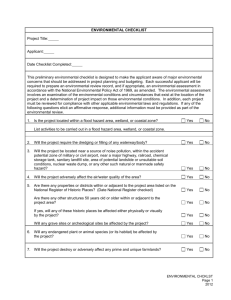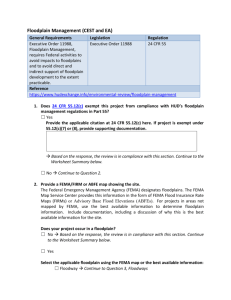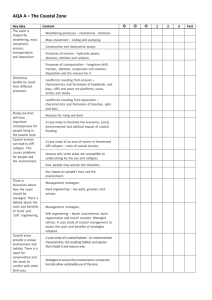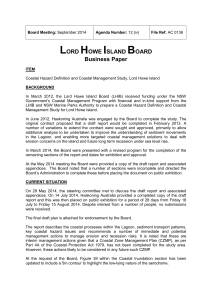ENVIRONMENTAL REVIEW INFORMATION FOR ESG: PROJECT
advertisement
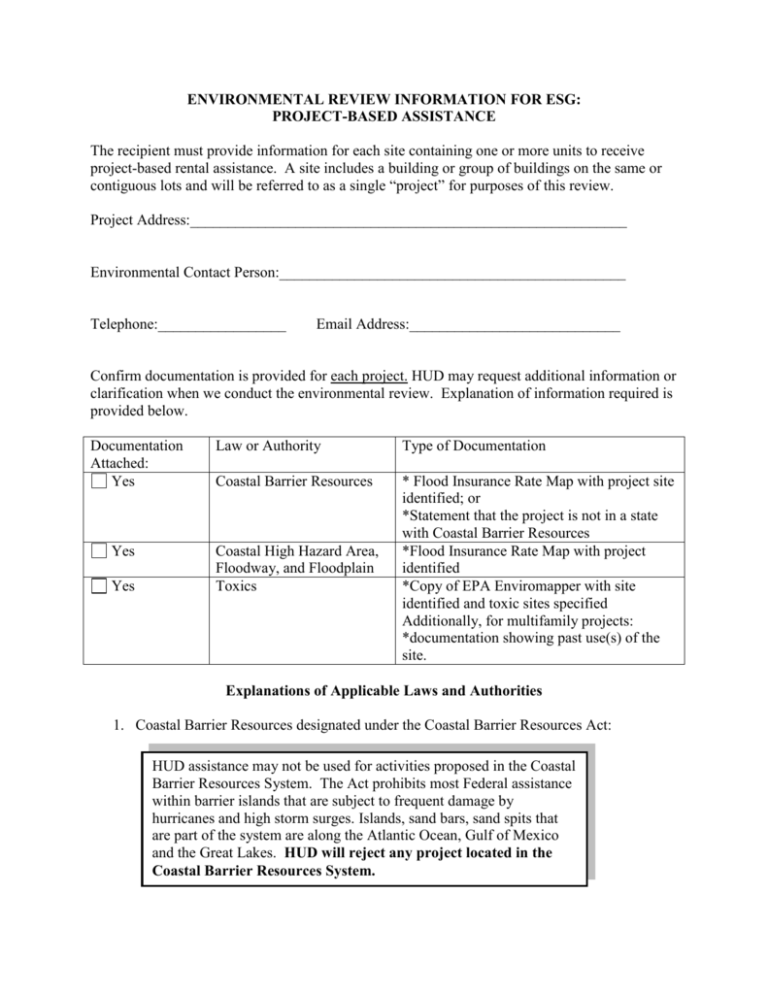
ENVIRONMENTAL REVIEW INFORMATION FOR ESG: PROJECT-BASED ASSISTANCE The recipient must provide information for each site containing one or more units to receive project-based rental assistance. A site includes a building or group of buildings on the same or contiguous lots and will be referred to as a single “project” for purposes of this review. Project Address:__________________________________________________________ Environmental Contact Person:______________________________________________ Telephone:_________________ Email Address:____________________________ Confirm documentation is provided for each project. HUD may request additional information or clarification when we conduct the environmental review. Explanation of information required is provided below. Documentation Attached: Yes Yes Yes Law or Authority Type of Documentation Coastal Barrier Resources * Flood Insurance Rate Map with project site identified; or *Statement that the project is not in a state with Coastal Barrier Resources *Flood Insurance Rate Map with project identified *Copy of EPA Enviromapper with site identified and toxic sites specified Additionally, for multifamily projects: *documentation showing past use(s) of the site. Coastal High Hazard Area, Floodway, and Floodplain Toxics Explanations of Applicable Laws and Authorities 1. Coastal Barrier Resources designated under the Coastal Barrier Resources Act: HUD assistance may not be used for activities proposed in the Coastal Barrier Resources System. The Act prohibits most Federal assistance within barrier islands that are subject to frequent damage by hurricanes and high storm surges. Islands, sand bars, sand spits that are part of the system are along the Atlantic Ocean, Gulf of Mexico and the Great Lakes. HUD will reject any project located in the Coastal Barrier Resources System. The following states have Coastal Barrier Resources: Alabama, Connecticut, Delaware, Florida, Georgia, Louisiana, Maine, Maryland, Massachusetts, Michigan, Mississippi, Minnesota, New Jersey, New York, North Carolina, Ohio, Puerto Rico, Rhode Island, South Carolina, Texas, U.S. Virgin Islands, Virginia, and Wisconsin. If your project is not in one of these states you may indicate that there are no Coastal Barrier Resources in your state and Continue to #2. If your project is in one of the states listed above provide a flood map from FEMA that documents the project site is not in a Coastal Barrier Resources Unit. o The FEMA web site is at http://www.msc.fema.gov. Assistance in making a map (FIRMette) is found by going to the FIRMette tutorial at the bottom of the page. Provide a copy of the FIRMette with the project site identified to HUD. o A sample FIRMette that identifies an area in the Coastal Barrier Resources System is attached to help you identify what the Coastal Barrier Resource would look like on the FEMA map. The hatched lines identify the area in a Coastal Barrier Resources Unit (see legend inserted in FIRMette). 2. Coastal High Hazard Area and Floodway The Coastal High Hazard Area is an area of special flood hazard extending from offshore to the inland limit of a primary frontal dune along an open coast and any other area subject to high velocity wave action from storms or seismic sources. The Floodway is that portion of the floodplain which is effective in carrying flow, where the flood hazard is the greatest, and where water depths and velocities are the highest. HUD will reject any project located in a Coastal High Hazard Area or a Floodway. You must provide a FIRMette to document whether your project is located in a Coastal High Hazard Area or floodway (remember to identify where your project is located). Coastal High Hazard Areas are identified in the FIRM map as zone “V”. See the attached example FIRMette. Floodways are identified in the FIRM map by a “cross hatch” (an example is not included on the attached FIRMette). 3. Toxic Chemicals and Radioactive Materials All property proposed for use in HUD programs must be free of hazardous materials, contamination, toxic chemicals and gases and radioactive substances, where a hazard could affect the health and safety of occupants or conflict with the intended utilization of the property. The environmental review of multifamily housing with 5 or more dwelling units must include a review of previous uses of the site to assure the proposed occupants are not impacted by any of these hazards. Since HUD is often unable to conduct a site inspection on each site, we will rely on you to provide information that will give us an understanding of any potential contamination on the site. Please provide: A report of nearby toxic sites and releases using EPA’s mapping service at http://www.epa.gov/enviro/index.html or similar service. To obtain a map, insert the project address in the box under the title “Get the Envirofacts” and press enter. Print the map and list of EPA regulated sites. For each EPA regulated site listed, print the compliance report. If you are providing assistance to 5 or more units in one building (multifamily assistance) provide documentation showing past uses of the site. Examples of types of documentation could be any of the following: o Historical aerial photographs of the site showing the status of the site through time. You do not need to go back further than 1940. These photos may be available at the local library or the local planning department. Ask if they have access to Sanborn Fire Insurance Maps or other historical mapping data. o A letter from someone who has specific information on the history of the site, for example the current or previous owner, the local historian, an elder in the community, the local planning department. The letter should indicate who the person is, the date the information is provided, how they have particular knowledge on the site, and the specific information on the previous uses of the site. o A Phase I Environmental Assessment Report. If a Phase I report is provided, none of the above toxics information is needed (the Envirofacts map, historic aerial photographs, and the letter from someone with specific information on the site.) These items will be included in the Phase I. 1. Floodplain Management The 100 year floodplains are areas where each year there is a 1% chance of flooding and over the life of a 30 year mortgage, there is a 26% chance of flooding. People and property are at risk in the 100 year floodplain and HUD discourages the use of Mc Kinney-Vento Act funds in these areas. While HUD will not deny assistance to projects of 4 or fewer existing units in a floodplain solely on its location in a floodplain, we strongly recommend grantees choosing to place people in these areas encourage participants to maintain personal flood insurance. Project based assistance of 5 or more units will require an analysis to determine if there are other practicable alternatives to locating the project in the floodplain. The public is invited to identify other alternatives to the project and comment on the analysis through two public notices. This process is time and labor intensive with a minimum of 22 days of public comment period. HUD will reject the project of 5 or more units in a flood plain if it is determined there are practicable alternatives. The FIRMette you provided above will be used to determine if your project is located in a 100 year floodplain or a floodway (remember to identify where your project is located). The 100 year floodplain is identified in the FIRM map as zone beginning with “A”. Contact your HUD program official immediately for further instructions if the project is for 5 or more units in a 100 year floodplain.

